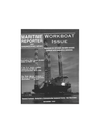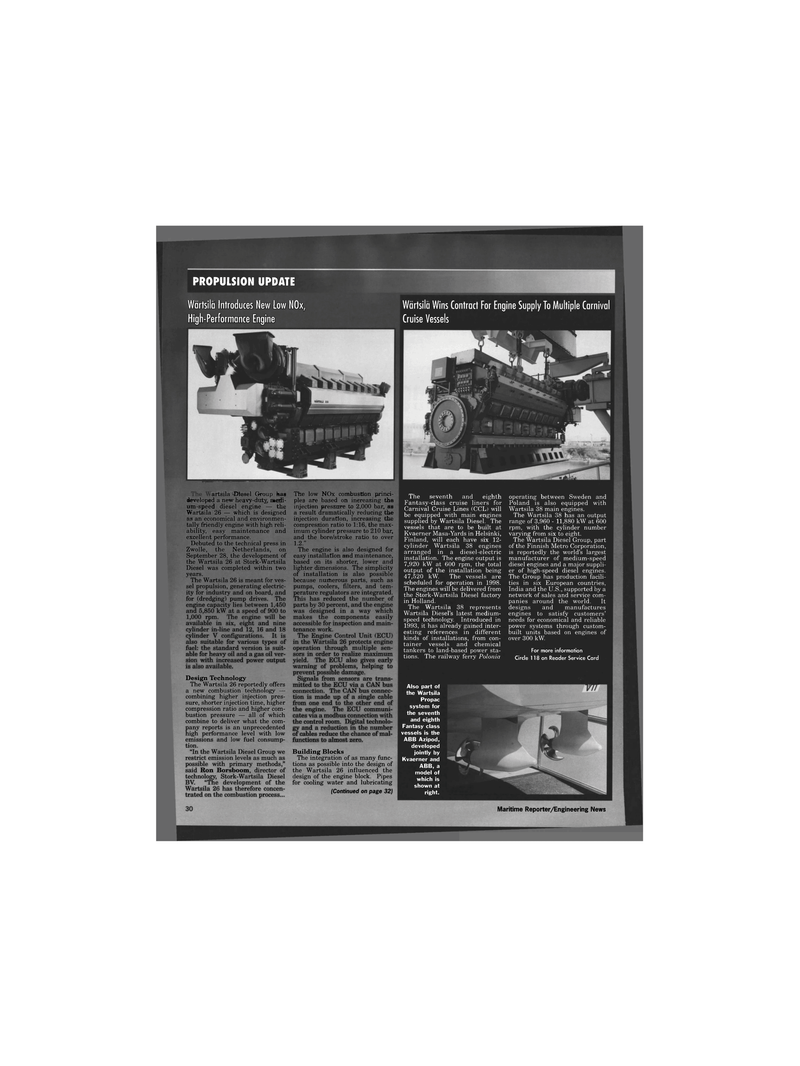
Page 28: of Maritime Reporter Magazine (November 1995)
Read this page in Pdf, Flash or Html5 edition of November 1995 Maritime Reporter Magazine
PROPULSION UPDATE
Wartslla Introduces New Low NOx, Wartsila Wins Contract For Engine Supply To Multiple Carnival
High-Performance Engine Cruise Vessels
The seventh and eighth
Fantasy-class cruise liners for
Carnival Cruise Lines (CCL) will be equipped with main engines supplied by Wartsila Diesel. The vessels that are to be built at
Kvaerner Masa-Yards in Helsinki,
Finland, will each have six 12- cylinder Wartsila 38 engines arranged in a diesel-electric installation. The engine output is 7,920 kW at 600 rpm, the total output of the installation being 47,520 kW. The vessels are scheduled for operation in 1998.
The engines will be delivered from the Stork-Wartsila Diesel factory in Holland.
The Wartsila 38 represents
Wartsila Diesel's latest medium- speed technology. Introduced in 1993, it has already gained inter- esting references in different kinds of installations, from con- tainer vessels and chemical tankers to land-based power sta- tions. The railway ferry Polonia operating between Sweden and
Poland is also equipped with
Wartsila 38 main engines.
The Wartsila 38 has an output range of 3,960 - 11,880 kW at 600 rpm, with the cylinder number varying from six to eight.
The Wartsila Diesel Group, part of the Finnish Metro Corporation, is reportedly the world's largest manufacturer of medium-speed diesel engines and a major suppli- er of high-speed diesel engines.
The Group has production facili- ties in six European countries,
India and the U.S., supported by a network of sales and service com- panies around the world. It designs and manufactures engines to satisfy customers' needs for economical and reliable power systems through custom- built units based on engines of over 300 kW.
For more information
Circle 118 on Reader Service Card 30 Maritime Reporter/Engineering News
Also part of the Wartsila
Propac system for the seventh and eighth
Fantasy class vessels is the
ABB Azipod, developed jointly by
Kvaerner and
ABB, a model of which is shown at right. artsila Diesel Group has developed a new heavy-duty, medi- um-speed diesel engine — the
Wartsila 26 — which is designed as an economical and environmen- tally friendly engine with high reli- ability, easy maintenance and excellent performance.
Debuted to the technical press in
Zwolle, the Netherlands, on
September 28, the development of the Wartsila 26 at Stork-Wartsila
Diesel was completed within two years.
The Wartsila 26 is meant for ves- sel propulsion, generating electric- ity for industry and on board, and for (dredging) pump drives. The engine capacity lies between 1,450 and 5,850 kW at a speed of 900 to 1,000 rpm. The engine will be available in six, eight and nine cylinder in-line and 12, 16 and 18 cylinder V configurations. It is also suitable for various types of fuel: the standard version is suit- able for heavy oil and a gas oil ver- sion with increased power output is also available.
Design Technology
The Wartsila 26 reportedly offers a new combustion technology — combining higher injection pres- sure, shorter injection time, higher compression ratio and higher com- bustion pressure — all of which combine to deliver what the com- pany reports is an unprecedented high performance level with low emissions and low fuel consump- tion. "In the Wartsila Diesel Group we restrict emission levels as much as possible with primary methods," said Ron Borsboom, director of technology, Stork-Wartsila Diesel
BV. "The development of the
Wartsila 26 has therefore concen- trated on the combustion process...
Building Blocks
The integration of as many func- tions as possible into the design of the Wartsila 26 influenced the design of the engine block. Pipes for cooling water and lubricating (Continued on page 32)
The low NOx combustion princi- ples are based on increasing the injection pressure to 2,000 bar, as a result dramatically reducing the injection duration, increasing the compression ratio to 1:16, the max- imum cylinder pressure to 210 bar, and the bore/stroke ratio to over 1.2."
The engine is also designed for easy installation and maintenance, based on its shorter, lower and lighter dimensions. The simplicity of installation is also possible because numerous parts, such as pumps, coolers, filters, and tem- perature regulators are integrated.
This has reduced the number of parts by 30 percent, and the engine was designed in a way which makes the components easily accessible for inspection and main- tenance work.
The Engine Control Unit (ECU) in the Wartsila 26 protects engine operation through multiple sen- sors in order to realize maximum yield. The ECU also gives early warning of problems, helping to prevent possible damage.
Signals from sensors are trans- mitted to the ECU via a CAN bus connection. The CAN bus connec- tion is made up of a single cable from one end to the other end of the engine. The ECU communi- cates via a modbus connection with the control room. Digital technolo- gy and a reduction in the number of cables reduce the chance of mal- functions to almost zero.

 27
27

 29
29
